Chapter 11
Helping Buyers Find You with Pay-Per-Click Ads
In This Chapter
![]() Understanding and leveraging Google AdWords
Understanding and leveraging Google AdWords
![]() Writing ad copy that compels and converts leads
Writing ad copy that compels and converts leads
![]() Creating your first ad with Google AdWords
Creating your first ad with Google AdWords
![]() Measuring your ad performance over time
Measuring your ad performance over time
Pay-per-click (PPC) advertising is a highly effective form of lead generation that leverages online ads on a variety of websites, including search engines. For a PPC ad, an advertiser pays only if a visitor clicks on the ad. PPC ads are typically highly targeted using demographic and search criteria. Some PPC ads can also be behavioral, appearing on various websites that a lead visits after he leaves your page.
In today’s noisy, multichannel world, PPC ads help your brand be seen across multiple channels including search and other websites. Wherever your lead goes, you go! Plus, if you aren’t yet appearing on the first page of Google, PPC ads can help you be seen by your target audience, as paid advertising appears on the first page of results.
Getting Started
In this section, I focus primarily on search engine PPC ads because they are often the highest converting. The first step to getting started with PPC ads is to determine your goals. What are you trying to get leads to do? A good thing to note here is that you are now paying for ads and are starting to delve in outbound marketing techniques, so think clearly about your CTAs and your offers.
Starting a Google AdWords account
One of the first things you need to do is to create a Google AdWords account so you can create your ads and research your keywords. Go to www.google.com/adwords/ and create your account.
To create a campaign, you have to make decisions about the following settings:
- General: Name your campaign so you have a clear idea what your ad is relating to. Come up with a standard naming convention that works for your company so that you can quickly scan for a campaign among a list (you will be building several over time).
- Type: Google allows their users to set their ad type based on goals such as Search and Display. That way, you can tailor your setup process to the type of ad you are placing.
- Location and Languages: You can select options for your ad to display only for people searching in certain locations. You can also specify a language. This option lets you fine-tune your target audience.
- Networks and Devices: Google allows you to control where your ads appear — directly in search results on its own websites or on partner networks (where other websites may lease Google’s search bar and results, instead of spending energy building their own). You can also target certain devices, such as smartphones and tablets.
- Bidding and Budget: Set your bids and budgets. Your default bid is the most you’re willing to pay per click for ads in your ad group. Your budget is the average amount you want to spend each day, total, on your campaigns.
- Ad Extensions: You can also include additional information on your ads such as links, your location, phone number, or Google+ page address.
After you get the hang of Google AdWords, you can then go in and set a campaign start and end date, schedule your ads for certain days of the week, or schedule your ads when they are most likely to get more clicks.
Take a look at the Google AdWords dashboard in Figure 11-1 to see what your PPC campaigns look like in the tool.
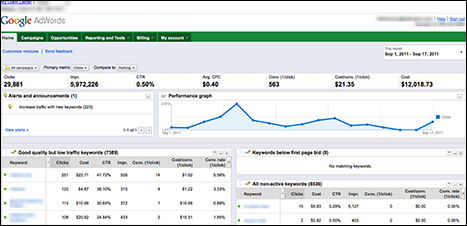
Figure 11-1: The Google AdWords dashboard.
Creating your offer mix
When starting to create your PPC strategy, you want to first think about your objectives. What are your goals for your PPC ads? Driving opportunities or conversions? Or are you focusing on brand awareness? Because each company is different, your offer mix will be unique based on your business priorities.
As you do with many lead-generation strategies, think about how your PPC ads map to the sales funnel. You want to catch leads in each stage of the sales funnel; therefore, you have to create ads and offers that map to lead buying stage and search queries.
For instance, if someone searches for what is marketing automation, she’s most likely in the beginning of researching marketing automation, so that person should be provided with a top-of-funnel-targeted ad and asset. If your lead is searching for the definition of your product, she certainly isn’t ready to buy.
In contrast, if someone searches for comparing marketing automation vendors, that person is farther along in the buying process and therefore should get a mid- to late-stage ad and asset discussing the differences between various vendors.
Here are some desirable outcomes for PPC that you might want to keep in mind as you determine your offer mix:
- Attracting site visitors that are actively looking for your product or service
- Keeping tight control of messaging throughout your buying funnel
- Increasing keyword ranking and traffic to your website
- Gaining insight into people’s search queries and behaviors
- Tracking ROI details through paid advertising metrics
- Increasing your database size
Defining your audience
As with any successful lead-generation campaign, with PPC, you need to define your audience. Defining your audience also helps you conduct more thorough keyword research, determine who and how you can target leads, and have more proactive brainstorming sessions.
Based on the goals you determine, ask yourself the following questions:
- Who is my key target audience for this campaign?
- Am I going to be targeting based on physical location?
- Am I going to be targeting based on device (mobile, tablet, computer)?
- What pain points or questions will my ad address?
- What point in the buying cycle do I want to focus on with my ads?
- Do I want to be targeting people searching for competitors’ keywords?
By answering this short series of questions, you can frame your list and have a better understanding of your ad copy, landing page copy, and the right CTA for your audience.
Choosing your keywords
After you have your goals outlined, know where your PPC ads fit in your funnel, and have started a Google AdWords account, it’s time to choose your keywords. The best place to start is with a brainstorming session between you and your team. For each top keyword, think of all the iterations or phrases that might pertain to your goals.
Keep track of your brainstorming keywords in a spreadsheet. Here is an example of what a brainstorm might look like for the phrase lead generation:
- Lead generation
- Generating leads
- Lead-generation marketing
- Lead-generation management
- Managing lead generation
- Lead-generation tools
- Tools for lead generation
- What is lead generation?
- How can I do lead generation?
- Lead-generation solutions
- Sales lead generation
- Lead-generation programs
- Programs for lead generation
- B2B lead generation
- Automated lead generation
You can also reference a keyword tool. Google AdWord provides a Keyword Planner. Simply go to the Tools and Analysis navigation on your home page and click Keyword Planner. Alternatively, you can also do a Google search for keyword tool or keyword generator and find tools that way.
Take a look at Figure 11-2 for a look inside Google Keyword Planner and its feedback for the keywords hotels cabo. Their tool shows you relevant keywords, average monthly searches, competition, and average cost-per-click (CPC).
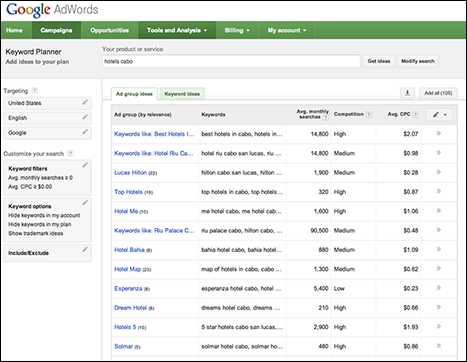
Figure 11-2: Google AdWords Keyword Planner.
From the information you gather with a keyword planner, you can then determine which keywords are your best bet for generating leads.
Then combine like keywords together to form ad groups. According to Web Marketing Today, an online magazine that includes marketing tips and advice, a best practice is 10–15 keywords per group. Sometimes, however, it makes sense to do more or fewer. Groups and segmentations can be determined by like words or meanings. Using my lead generation keyword example, I can have a group for lead-generation software and include all of the iterations of lead-generation software.
After you have your keywords selected, ask yourself
- How relevant is this keyword to my website, my products and services, and my content?
- If someone searches for this keyword, will she find my offerings useful?
- Do I have content to offer for this keyword or will I have to create this content?
Making ad-specific landing pages
All PPC ads should go to a landing page that speaks to your exact offer. It is a bad practice for a PPC ad to go to a page on your website. You want leads to engage with your offer and ultimately fill out a form so you can get that valuable conversion. If your landing page doesn’t speak to your ad or their search query, they will bounce.
In the next section, I cover what you want the user experience to be when it comes to PPC ads and landing pages. I have entered the search query how can I track marketing analytics in Google. On the results page, I see three ad options. I'll click the Marketing Analytics Guide — Equate Marketing with Revenue ad. Sounds perfect and aligns to my initial query.
Take a look at my search query and the related ads in Figure 11-3.
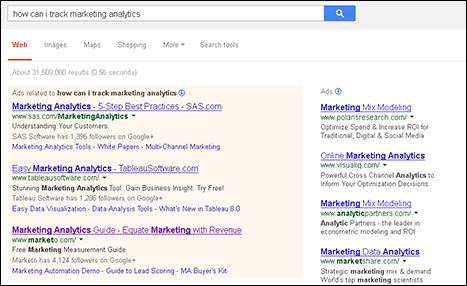
Figure 11-3: A Google search query.
After I click the ad, I'm brought to a specific landing page that is unique to my ad, as shown in Figure 11-4. Notice that the main heading (H1) of the landing page closely matches the ad.
The landing page also follows these standard lead-generation best practices by having
- Engaging graphics
- Bold copy
- Bullet points that clearly outline what is in the asset download
- A clear CTA button
- A short form
The main point to take away here is that once I click on the ad, I am brought right away to a page that speaks to my search. As a result, I am way more apt to fill in my information. If I had been brought to a generic website page, I probably would have left to go search for something else more applicable.
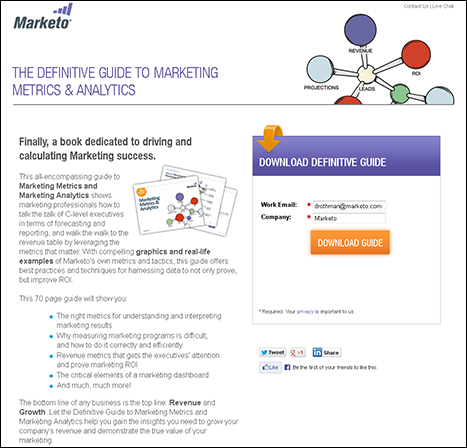
Figure 11-4: A model PPC landing page.
Creating Your Ad Copy
The next step to a great PPC campaign is writing your ad copy. This is tricky because you have limited space to get your message across. Basically, you have one 25-character headline and two 35-character lines to entice your leads to click. Pretty challenging, right?
Creating ad copy is a critical part of your PPC campaign. However, don’t worry too much because you can easily test your copy and change your ads instantaneously through AdWords.
Here are five golden rules of PPC ad writing according to Search Engine Watch:
- Use clear, easy-to-understand words
- Use vivid, emotional language
- Focus on both keywords and more importantly, the intent behind them
- Have a clear compelling offer and CTA
- Don’t go overboard with abbreviations and truncated phrasings
Be sure to do some competitive research to see what your competitors are doing. Make sure your copy stacks up to theirs!
Targeting and relevancy
Consider what your leads are searching for when they come across your ad, and write copy that resonates with their need. Be sure to address pain points directly, either by calling them out or by creating copy that addresses the issue. If your ad isn’t relevant, your lead will not click.
As an example, I searched for buying a CRM solution. Take a look at the results in Figure 11-5. Out of the paid ads at the top of my search, the ad from Business-software.com is the most relevant to my search in both headline and copy. If I click their ad, I'm promised an analysis of the top 40 CRM vendors. This is perfect for my query.

Figure 11-5: Relevant headlines and copy.
Crafting your title
Your ad headline is what stands out the most, and a winning headline grabs the attention of your lead and compels her to click. Headlines are so important, in fact, that 80 percent of people will only read a PPC ad headline, whereas only 20 percent actually read the rest. You have very limited real estate to create a title that draws your leads to you.
Create headlines that are emotional. If a person is searching, he is looking for information or, better yet, he has a problem that needs to be solved. Emotional writing elicits an emotional response from your lead. Use strong verbiage and don’t be afraid to use words or phrases such as now, warning, #1, and so on. As a test, I conducted a search for PPC ad help. Figure 11-6 shows the ads that appeared in my search results. All three ads used emotional language to draw me in, such as best and leader. Each business wants me to believe that they are the best at what they do.
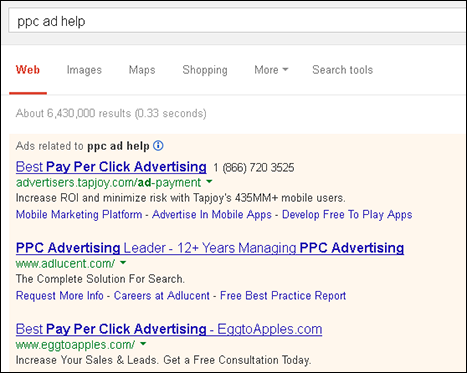
Figure 11-6: Emotional PPC headlines.
These headlines show authority by using language that describes the advertiser as a leader in the space. As a searcher, I want to click the ad for the company that is the best at helping with PPC ads.
In my search, I found another great example of a creative PPC headline. Figure 11-7 shows an ad from a company called BoostCTR. They use a question in their headline to grab my attention.

Figure 11-7: Using questions in PPC headlines.
Here is another great example from BoostCTR, as seen in Figure 11-8. For my next search, I input writing PPC ad copy. Their ad popped up again — not only with a question this time, but also with an affirming statement of 50 percent click-through improvement. They're speaking directly to me through a question, but also showing authority by claiming my CTR will go up 50 percent if I use their service.
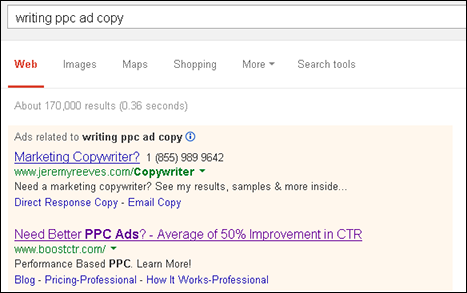
Figure 11-8: Showing authority and ROI in PPC headlines.
Writing your ad copy and CTAs
Your ad copy is also critical to lead conversions, and you have to cram in a lot in a very small space. It needs to show value, credibility, and must stand out. Whereas you might shy away from capital letters and exclamation points in your regular marketing copy, all bets are off for PPC: You have to grab the attention of a lead amidst a sea of search noise.
Each ad should focus on one keyword, show value, and have a strong CTA if applicable. Take a look at the results I get when I search for sales performance in Figure 11-9. The first hit I get is from a company called Fantasy Sales Teams. Immediately I'm drawn to the name of their company. But more importantly, their ad copy speaks to their audience and includes a compelling reason for me to click. Who wouldn’t want to model a sales contest after fantasy sports? It's a win-win and they clearly understand their audience.

Figure 11-9: Compelling PPC ad copy.
When I conducted the search marketing analytics shown in Figure 11-10, an ad from Tableau Software came up with a strong CTA to try their software for free. They have very concise copy reading, Gain business insight. Try Free!. Their call-to-action is clear.

Figure 11-10: A strong CTA in PPC ad copy.
Basically, your ad copy must be concise and have a strong point-of-view or CTA. LunaMetrics recently released a handy cheat sheet that lists out some of the most compelling CTA words to use in a PPC ad. String these words together and voilà! You have strong ad copy. See a snippet of their cheat sheet in Figure 11-11.

Figure 11-11: The LunaMetrics call-to-action cheat sheet.
Creating a sample PPC ad
Now that you have a good sense of how to write your ad headline and copy, dig in and actually create a sample PPC ad via Google AdWords:
- Sign into your Google AdWords account and click Create Your First Campaign.
- Next, fill in the following information:
- Campaign Name: Name it anything that's easy to remember.
- Campaign Type: You can choose Search Network Only or Leverage Partner Sites. Your choice dictates the networks you are participating in.
- Location: Enter an area to target or exclude. Click one of the radio buttons to select a very large area, such as the United States. Select Let Me Choose and enter your choice in the box below to select a more specific region or city.
- Language: English is selected by default. Click Edit to select another language.
- Bid Strategy: Set your own bids or have AdWords set your bids.
- Budget: Enter the maximum dollar figure you'd like to spend daily.
- Ad Extensions: You can extend your ad with location information, site links, phone number, and your Google+ profile.
- The next step is to create the ad itself. Name your ad group, write your headline, write your copy, and select your keywords.
Note that Google AdWords has a preview screen on the right side so you can see what your ad looks like.
- Click Save and Continue and enter in your billing information.
Tracking Your Ad Performance
PPC ads have very clear performance indicators and metrics. Because your ads are easy to adjust, it's important to constantly keep track of the results so you can optimize your ads. Writing the right ad copy and getting the click can be a guessing game, and by vigilantly checking metrics, you can be agile and pivot strategies when needed.
Google Quality Score
The Google Quality Score aligns nicely with many of their new algorithm updates because it takes a look at the relevancy and quality of your ads, keywords, and landing pages. Having a high Quality Score means more than just being in the Google club. It also means that you might have a better ad position than someone who has a low score. By having a high Quality Score, you can also be eligible for certain ad extensions, and it affects your CPC, so this metric matters.
According to Google, your Quality Score is based on the following elements:
- Expected Keyword Click-Through Rate (CTR): Metric calculated based on past CTR and historical performance of the keyword in your ad
- Display URL’s Historical CTR: How often your display URL receives clicks
- Account History: Overall CTR numbers on all ads and keywords
- Landing Page Quality: How relevant your landing page is and how easy it is to view
- Keyword/Search Relevance: How relevant your keyword is to what a searcher is looking for
- Keyword/Ad Relevance: How relevant your ad is to your keyword
- Ad Performance: How an ad performs on Google and partner sites
- Targeted Devices: How well your ad performs on multiple devices such as laptops, mobile phones, and tablets
- Geographic Performance: How successful you have been in regions you are targeting
Exploring basic PPC metrics
There are many standard metrics for PPC measurement. Many can be found in Google Analytics — they give a very easy read-out of performance — but it's good to know basic definitions and what you should be looking out for.
Here are some standard measurements that you want to keep in mind:
- Impressions: The measurement of how many times your ad is displayed when someone types in your search term. Note that this metric does not track clicks: It only tracks the number of times your ad actually appears.
- Click: The number of times your ad is actually clicked by a searcher.
- Conversion: The number of times a lead takes an intended action — that is, downloading a piece of content or attending a webinar. You can keep track of conversions in both Google Analytics and your marketing automation program.
- Spend: The amount of money you spend on a campaign.
And now you can have some real fun! You can combine these measurements to come up with other awesome measurements to analyze campaign performance:
- Click-through rate (CTR): This is the percent of impressions that yield clicks (clicks divided by impressions).
- Cost per click (CPC): This refers to the amount you are spending per click when you look at your entire campaign spending (spending divided by clicks).
- Conversion rate: This is your main metric and probably the most important of all paid search metrics. This is the percentage of clicks that actually convert (conversions divided by clicks).
Creating conversion tracking
It's important for you to know when a conversion ultimately came from one of your kick-butt PPC campaigns, so you can justify the monetary investment that you have invested into lead generation. In order to track that process, you need to set up conversion tracking. What is that, you say? Conversion tracking is when you (or your web developer) place a piece of code from Google AdWords in your landing page or thank-you page so you know how often a lead converts from your ad. The beauty here is now you know how well your ads are performing.
If you have a marketing automation tool, you can set up separate tracking codes for each landing page so the data reports back to your marketing automation platform. Then you can change a lead score and include your PPC ad in your reporting.
Some marketing automation tools now report back to Google with lead status information so you can view conversion data from your marketing automation directly in AdWords. Why is this useful? In the past, Google AdWords was only able to measure online conversions, but with these new integrations, you can now track when a click on your ad resulted in a qualified lead, opportunity, or new customer.
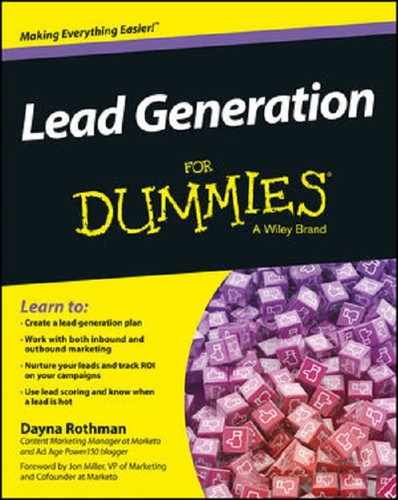
 Every good PPC campaign should have a custom landing page. I highly urge you to stay away from using your home page as the landing page. More on PPC landing pages later in this section.
Every good PPC campaign should have a custom landing page. I highly urge you to stay away from using your home page as the landing page. More on PPC landing pages later in this section. Many keywords are similar to your SEO keywords that were discussed in Chapter
Many keywords are similar to your SEO keywords that were discussed in Chapter